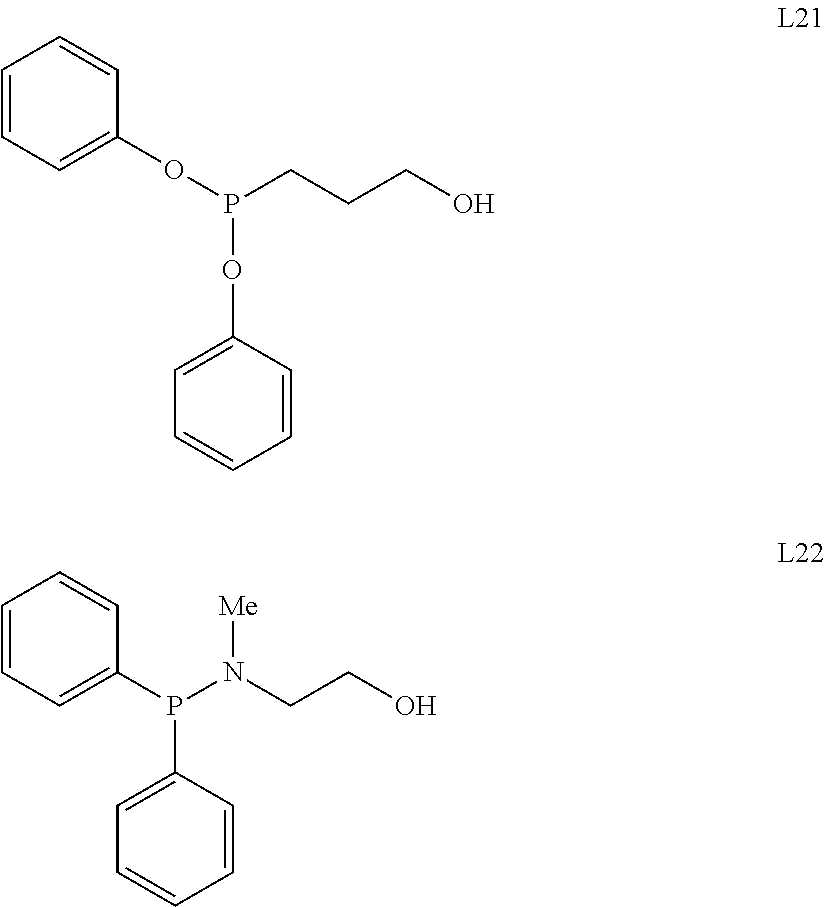Process for dimerization of ethylene to but-1-ene using a composition comprising a titanium-based complex and an alkoxy ligand functionalized by a heteroatom
a technology of but-1-ene and dimerization process, which is applied in the direction of catalyst activation/preparation, group 3/13 element organic compounds, hydrocarbon preparation catalysts, etc., can solve the problems of considerable difficulty in industrial operation, small practical use, and considerable complexity of the procedur
- Summary
- Abstract
- Description
- Claims
- Application Information
AI Technical Summary
Benefits of technology
Problems solved by technology
Method used
Image
Examples
example 1
Synthesis of the Complex [(L7)2Ti(OiPr)2]
[0043]3.6 g (35 mmole) of ligand L7, 10 mL of dry cyclohexane and 5 g (17.5 mmole) of [Ti(OiPr)4] (where iPr stands for isopropyl) were introduced into a Schlenk flask under argon at ambient temperature. This mixture was then heated under reflux for 30 min and stirred overnight, still under argon. Evaporation of the solvent produced the complex [(L7)2Ti(OiPr)2] in the form of an orange oil. The yield was almost quantitative. The structure of the complex was confirmed by 1H and 13C NMR analyses.
example 2
Synthesis of the Complex [(L8)2Ti(OiPr)2]
[0044]3.4 g (35 mmole) of ligand L8, 10 mL of dry cyclohexane and 5.0 g (17.5 mmole) of [Ti(OiPr)4] were introduced into a Schlenk flask under argon at ambient temperature. This mixture was then heated under reflux for 30 min and stirred overnight, still under argon. Evaporation of the solvent produced the complex [(L8)2Ti(OiPr)2] in the form of a dark orange oil. The yield was almost quantitative. The structure of the complex was confirmed by 1H and 13C NMR analyses.
example 3
Synthesis of the Complex [(L9)2Ti(OiPr)2]
[0045]3.8 g (35 mmole) of ligand L9, 10 mL of dry cyclohexane and 5.0 g (17.5 mmole) of [Ti(OiPr)4] were introduced into a Schlenk flask under argon at ambient temperature. This mixture was then heated under reflux for 30 min and stirred overnight, still under argon. Evaporation of the solvent produced the complex [(L9)2Ti(OiPr)2] in the form of a colourless oil. The yield was almost quantitative. The structure of the complex was confirmed by 1H and 13C NMR analyses.
PUM
| Property | Measurement | Unit |
|---|---|---|
| molar ratio | aaaaa | aaaaa |
| temperature | aaaaa | aaaaa |
| temperature | aaaaa | aaaaa |
Abstract
Description
Claims
Application Information
 Login to View More
Login to View More - R&D
- Intellectual Property
- Life Sciences
- Materials
- Tech Scout
- Unparalleled Data Quality
- Higher Quality Content
- 60% Fewer Hallucinations
Browse by: Latest US Patents, China's latest patents, Technical Efficacy Thesaurus, Application Domain, Technology Topic, Popular Technical Reports.
© 2025 PatSnap. All rights reserved.Legal|Privacy policy|Modern Slavery Act Transparency Statement|Sitemap|About US| Contact US: help@patsnap.com



